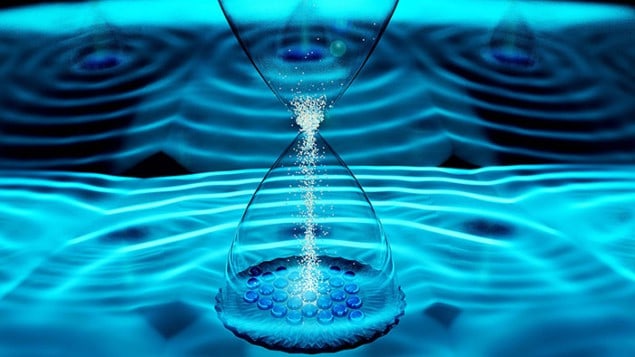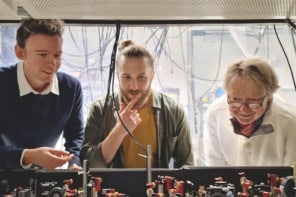
Two independent groups of physicists in the US have built what they describe as “time crystals” – systems of interacting particles that are driven by a periodic force but which appear to oscillate autonomously. These are not the same as the theoretical time crystal outlined by Nobel-prize-winner Frank Wilczek five years ago, which it was alleged could break time symmetry by oscillating indefinitely without any energy input. But the researchers report that their systems seem to break what is known as discrete time symmetry.
Wilczek put forward his idea in analogy with the highly ordered lattice structure seen in physical crystals such as salt or diamond. The laws of physics tell us that empty space exhibits a symmetry such that no point is different to any other, but crystals break this symmetry since their constituent atoms or molecules sit at very well-defined locations. Given that crystals exist in thermodynamic equilibrium, Wilczek wondered whether it might be possible for systems of particles to spontaneously form repeating structures in time, even in their lowest energy states.
In 2012, Wilczek argued that a time crystal could be created by applying a static magnetic field across a ring of quantum particles. These would then group together in clumps around the ring and rotate. But his proposal, which appears akin to a perpetual motion machine, proved controversial. Patrick Bruno, a theorist at the European Synchrotron Radiation Facility in France, published an analysis showing that the system would not be in its ground state, and that if it were, it wouldn’t rotate. Bruno’s critique was then generalized to show that such time crystals would be physically impossible.
A modest proposal
Undeterred, Wilczek and others recast the idea in a more modest form, such that the particles in the system do not exist in a true state of equilibrium. Such a “discrete time crystal” involves applying a set of periodic forces to a set of spins, such that the orientation of the spins oscillate at an integer multiple of the driving period. Rather than breaking time symmetry per se, this breaks the “discrete” symmetry already created by the driving fields. This is analogous to placing atoms of a different element at, say, every second or third atomic site on the surface of a crystal, which breaks the surface’s existing symmetry.
According to Christopher Monroe of the University of Maryland, who led one of the two experimental teams, these time crystals must have two particular properties if they are to be considered real, self-contained entities. One is “rigidity”, the ability to maintain a fixed oscillation period while external parameters – such as the driving period – vary. The other condition is that the system must not heat up, even though it requires energy to oscillate. “This allows us to drive the system, but have it remain in quasi-equilibrium,” he says.
These time crystals tick in a reliable way and have long-range correlations
Frank Wilczek, MIT
To create their time crystal, Monroe and colleagues used trapped ions. They exposed around a dozen strongly interacting ytterbium-ion spins to a sequence of periodic laser pulses. These pulses drove the system at a particular rate, while additional laser beams added randomness to each spin’s rotation – creating disorder that prevented the system from heating up. The researchers found that the oscillation period of the spins remained at the expected, fixed value – and, crucially, that it did so even when the pulse period changed slightly. “That is the smoking gun,” says Monroe. “It is a property of the system, like the fixed lattice of a crystal.”
Natural set-up
The other experiment, led by Mikhail Lukin of Harvard University, involved a less precise but more natural set-up. It consisted of nearly a million spins formed by impurities in diamond known as nitrogen-vacancy centres. The driving field in this case came in the form of microwave pulses, while the heat-suppressing noise arose naturally as a result of a random variation in the dipole interaction between vacancy centres. Here too, the researchers were able to oscillate spins at integer multiples of the driving period – twice and three times as long, in this case – which remained unaffected by changes to the driving parameters.
Chetan Nayak of Microsoft Station Q in California – who wrote a commentary to accompany two papers in Nature describing the work – says that the “rigidity” observed by the two groups provides evidence of discrete time crystals. But he says that the case will only become watertight when they show that the spin oscillations remain in phase for a period of time that is exponentially long compared with some parameter of the system, such as its physical length. “The next generation of experiments would have to overcome some technical hurdles to see this,” he says. “But I think that these hurdles can be overcome.”
Bruno, meanwhile, has a more basic objection. He argues that the latest results provide useful information in the study of non-equilibrium quantum systems, but that they fall a long way short of what he says would have been the “radical change of paradigm” accompanying a confirmation of Wilczek’s original theory. “For systems out-of-equilibrium, the spontaneous breaking of time-translation invariance, per se, is neither new, nor surprising, nor mysterious,” he says.
Wilczek, however, describes himself as “ecstatic” at the latest research. He concedes that the results do not constitute a “fundamental breakthrough in physics in the sense of rewriting the Standard Model, for example”. But he argues that being able to “spontaneously break discrete time symmetry” is “qualitatively new”. And he adds that the research could lead to practical applications, such as the development of a clock for quantum computers. “These time crystals tick in a reliable way and have long-range correlations,” he says.



